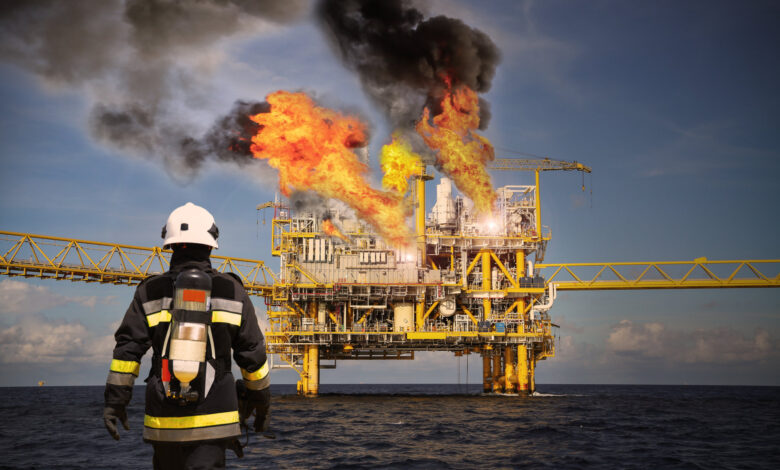Strategies to Prevent Explosions in Offshore Work Environments

Offshore work environments, including oil rigs and gas platforms, are notorious for their hazardous conditions. The mix of volatile substances, complex machinery, and the unforgiving nature of the sea creates a potent recipe for potential disaster. Among these, explosions stand out as particularly devastating, not only causing immediate harm to workers but also posing severe environmental threats. This article delves into the multifaceted approach required to mitigate the risks of explosions, ensuring the safety of personnel and the preservation of marine ecosystems.
Understanding the Risks
Offshore installations are engineering marvels, designed to extract and process highly flammable substances like oil and natural gas from beneath the sea floor. However, the very nature of these substances makes these sites inherently risky. Common causes of explosions include gas leaks, equipment failure, and human error. The Bureau of Safety and Environmental Enforcement (BSEE) reports that equipment failure accounts for approximately 44% of offshore incidents, underscoring the critical need for stringent maintenance and inspection regimes.
The impact of explosions extends far beyond the immediate vicinity of the blast. They can lead to significant loss of life, massive property damage, and catastrophic environmental disasters. The Deepwater Horizon oil spill of 2010, one of the most infamous offshore explosions, resulted in the deaths of 11 workers and the release of approximately 4.9 million barrels of oil into the Gulf of Mexico, illustrating the profound and lasting consequences of these incidents.
Regulatory Framework
To combat these risks, a comprehensive regulatory framework has been established at both international and national levels. Organizations such as the Occupational Safety and Health Administration (OSHA) and the International Maritime Organization (IMO) play pivotal roles in setting safety standards for offshore operations. These regulations encompass everything from the design of offshore installations to operational procedures and emergency response protocols.
In the United States, OSHA’s guidelines for offshore oil and gas operations set forth detailed requirements for equipment safety, employee training, and emergency preparedness. Similarly, the IMO’s International Convention for the Safety of Life at Sea (SOLAS) includes specific chapters dedicated to the prevention of fires and explosions on ships and offshore platforms.
Risk Assessment
A cornerstone of explosion prevention is the regular and thorough assessment of risks. Identifying potential hazards before they escalate into full-blown crises is crucial. This process involves a systematic examination of all aspects of offshore operations, from the integrity of drilling equipment to the handling and storage of volatile substances.
Advanced tools and technologies, including predictive analytics and real-time monitoring systems, have significantly enhanced the ability to detect anomalies that could lead to explosions. These systems can alert operators to issues such as gas leaks or equipment malfunctions, enabling swift action to mitigate risks.
Engineering Controls
At the heart of explosion prevention are engineering controls designed to eliminate or reduce hazards at their source. This includes the use of explosion-proof and intrinsically safe equipment that can withstand the harsh offshore environment and prevent sparks or overheating from triggering a blast. Regular maintenance and inspection are also vital to ensuring that all safety systems are fully operational.
Operational safety practices further bolster these engineering controls. For instance, strict protocols for the management of flammable gases and the use of non-sparking tools minimize the risk of accidental ignition. Emergency response plans, regularly updated and rehearsed, ensure that personnel are prepared to act decisively in the event of an incident.
The human element cannot be overlooked in the equation of offshore safety. Training programs that emphasize the importance of safety procedures and the correct use of personal protective equipment (PPE) are essential. Moreover, the impacts of loss of limb and other serious injuries highlight the dire consequences of safety lapses in these high-risk environments.
Continuing with the article, we will explore technological innovations in safety, the critical role of PPE, the importance of cultivating a strong safety culture, and the lessons learned from past incidents. Through a combination of stringent regulations, proactive risk management, and a commitment to safety at all levels, the offshore industry can navigate the challenges posed by its inherently dangerous work, safeguarding both human lives and the marine environment.
Technological Innovations
The offshore industry is continually evolving, with technological advancements playing a pivotal role in enhancing safety measures. Innovations such as drones and robotic inspections have revolutionized the way offshore facilities monitor for potential hazards, allowing for thorough inspections in areas that are difficult or dangerous for humans to access. Similarly, advancements in sensor technology enable the detection of gas leaks or structural weaknesses before they lead to disasters. These technologies not only improve the ability to prevent explosions but also reduce the need for human exposure to hazardous conditions.
Personal Protective Equipment (PPE)
In the realm of explosion prevention, Personal Protective Equipment (PPE) serves as the last line of defense. Essential items such as flame-resistant clothing, helmets, eye protection, and safety boots are designed to protect workers from the immediate effects of an explosion, including flames, debris, and toxic gases. Ensuring that all personnel are equipped with, and properly trained in the use of, the correct PPE is a fundamental aspect of offshore safety protocols. Regular maintenance and checks are crucial to ensure that all PPE meets the required safety standards and is fit for purpose.
Creating a Safety Culture
Beyond the implementation of regulations, technologies, and protective gear, the establishment of a safety culture within the organization is critical. A safety culture is characterized by shared beliefs, practices, and attitudes that prioritize safety above operational productivity or financial gains. Leadership plays a crucial role in fostering this culture, demonstrating a commitment to safety through actions and decisions. Encouraging open communication and feedback about safety concerns without fear of reprisal can lead to significant improvements in safety practices. Recognizing and rewarding safe behavior also reinforces the importance of safety and encourages a collective responsibility among all employees.
Case Studies
The lessons learned from past offshore explosions are invaluable in shaping current and future safety practices. One notable example is the Piper Alpha disaster in 1988, which resulted in 167 deaths and led to an overhaul of safety regulations in the North Sea. The investigation highlighted the need for robust permit-to-work systems and the importance of emergency preparedness. More recently, the Deepwater Horizon explosion in 2010 underscored the risks associated with deepwater drilling and led to significant advancements in blowout preventer technology. These case studies serve as sobering reminders of the potential consequences of safety failures and the continuous need for vigilance and improvement.
Conclusion
Preventing explosions in offshore work situations requires a multifaceted approach, combining stringent regulatory compliance, advanced technology, rigorous risk management, and a deeply ingrained culture of safety. While the challenges are significant, the offshore industry has made considerable strides in enhancing safety measures. Continuous improvement, driven by lessons learned from past incidents and technological advancements, remains essential. As we move forward, the collective commitment of all stakeholders to safety will be pivotal in safeguarding the lives of offshore workers and protecting the marine environment from the devastating impacts of explosions.
The journey towards absolute safety in offshore operations is ongoing, but with each step forward, we reinforce the foundations for a safer and more secure offshore working environment.



